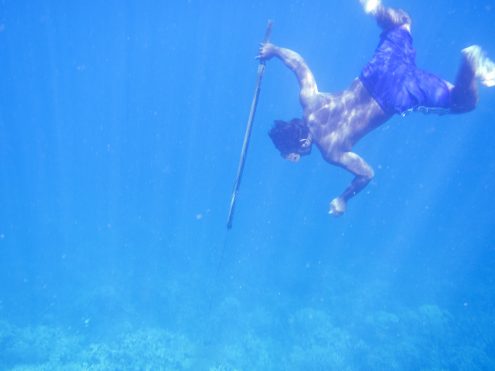Research from Center for GeoGenetics shows genetic adaptation to diving among human ‘sea nomads’
Ph.D. student Melissa Ilardo, from the Center for GeoGenetics, supervised by Professor Eske Willerslev and Professor Rasmus Nielsen, has uncovered the secret behind Southeast Asian sea nomads’ unique breath-holding ability. The research result was recently published in Cell.

Most people can hold their breath for one minute at a maximum. But the Bajaus, a coastal population from Southeast Asia who live as sea nomads, can hold their breath exceptionally longer when they free dive into the ocean searching for fish. The secret behind their impressive oxygen capacity has now been revealed by Ph.D. student Melissa Ilardo, who was supervised by head of center Eske Willerslev and Professor Rasmus Nielsen in her Ph.D. project.
The study was recently published in the prestigious scientific journal Cell, and the study’s result provides a rare example of the continuous evolution of humans.
For more than 1000 years, the Bajau people have travelled through the oceans of Southeast Asia in homemade houseboats, collecting food by free diving with spears. Now living among the Indonesian islands, they are known for their exceptional ability to hold their breath when diving. Members of the Bajau can dive up to 70 meters with nothing but a couple of weights and their traditional wooden diving masks. Since they don’t dive competitively, it remains unknown exactly how long they are able to hold their breath, but Ilardo was told by a Bajau member, that he once held his breath for 13 minutes.
For a long time, one scientific hypothesis has regarded the spleen as a crucial part of humans’ ability to free dive, but it was not until now, with Ilardo’s study, that research has proven a genetic connection between the size of the spleen and the ability to dive.
“There’s not a lot of information out there about human spleens in terms of physiology and genetics, but we know that deep-diving seals have disproportionately large spleens,” Ilardo said. She added: “Until now, it has been entirely unknown whether sea nomad populations genetically adapt to their extreme lifestyle.”
Using comparative ultrasounds between the Bajau people and their land-dwelling neighbors, the Salaun, who have minimum interaction with the sea, Ilardo found that the spleens of the Bajau people are 50% larger than the Salauns’. The spleen functions as an oxygen pump that sends a large number of red blood cells into the bloodstream when the human body experiences a drop in the level of oxygen. Hence, a larger spleen is an advantage for the Bajau divers because it increases their ability to sustain oxygen deficiency.
Ilardo was originally warned against pursuing this as her Ph.D. project, by her supervisors, Willerslev and Nielsen, who believed that it could be too risky.
“We told Melissa that this was a very risky Ph.D. project and she needed to be aware that it was likely she would find nothing,” said Professor Willerslev. “She said she wanted to do it anyway and that paid off. Melissa was right and our concerns were wrong.”
The large spleen is therefore the secret behind the Bajau people’s exceptional diving skills and also evolutionary proof of how a life underneath the sea has changed them genetically.
